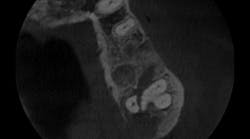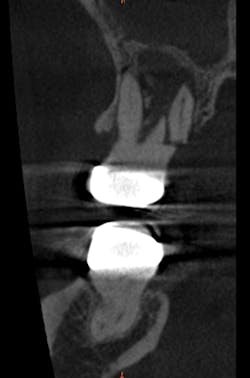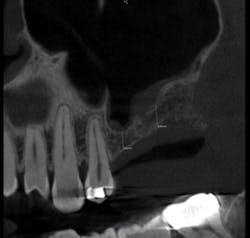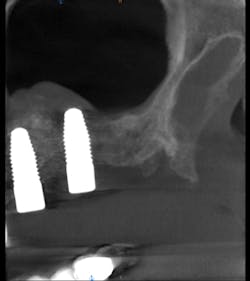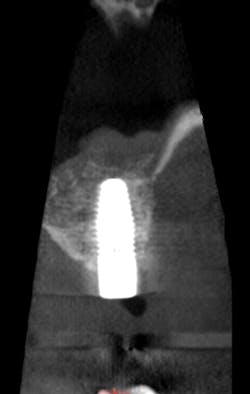Editor's note: This article is a part of Dental Economics' "Focus on Digital Dentistry," a social media feature for the month of October. Join the conversation on DE's facebook page or send us a tweet @dentalmagazine. #DEdigitalmonth
----------------
Cone beam computed tomography (CBCT) has been a part of my practice since I first implemented a unit in my office eight years ago. It’s proven to be a critical part of my diagnoses and treatment planning—especially in cases of root fractures.
Clinical Case
Recently, a 55-year-old female was referred to my practice for implant replacement of a maxillary first molar. The referring dentist recommended evaluation for a possible sinus lift prior to implant placement due to inadequate bone and evaluation of tooth No. 15. A periapical radiograph taken at a two-month follow up was included.
I prescribed a CBCT scan to evaluate site No. 14 prior to implant placement and to evaluate tooth No. 15. After capturing a CBCT scan on the CS 9300 (with a 5 cm x 5 cm field of view and a resolution of 90 μm), the image clearly showed a palatal root fracture on tooth No. 15 across from the cross-sectional and axial scan views (figs. 1, 2). Thanks to the enhanced diagnostic quality of the images, we decided to extract the tooth.
Figure 1:
Figure 2:
I acquired a post-extraction, small-field CBCT scan to evaluate the edentulous site for sinus health and bone height prior to sinus lift and simultaneous implant placement (fig. 3). Measurements from the crest of the alveolar ridge to the floor of the sinus were taken at the sites of the first and second molars, and were found to be 3.8 mm of bone height and 4.8 mm of bone height, respectively.
Figure 3:
After reviewing the image, we performed a sinus lift procedure and placed two implant fixtures. A follow-up CBCT volume was taken one month later to check for overall healing, graft containment and sinus health (figs. 4, 5). The scan demonstrated normal healing from all perspectives. The patient went on to have the implants successfully restored once integration was clinically confirmed.
Figure 4:
Figure 5:
Role of CBCT in Diagnoses and Treatment Planning
This was a case that clearly demonstrates the value of CBCT imaging in diagnoses and treatment planning. While the fracture was not clearly seen on a traditional 2D radiograph, it was confirmed with amazing clarity using small-field CBCT. Such an issue could have severely compromised the patient’s initially proposed treatment plan. In cases where traditional 2D radiography is uncertain or inconclusive, high resolution CBCT 3D imaging may eliminate any questions or variables, and should be considered to achieve the highest standard of diagnosis and treatment.
The growth of CBCT has been amazing to watch—seldom do we see such a rapid growth rate in dentistry of such a high-dollar product, indicating the importance and usefulness of the technology. I have never met anyone who regrets the decision of purchasing a CBCT unit and I would advise anyone who is thinking of incorporating a system into their practice to take the plunge, they won’t be disappointed.
--------
Editor's note: This article is a part of Dental Economics' "Focus on Digital Dentistry," a social media feature for the month of October. Have you used the CS 8100 3D? Write your comments below or join the conversation on DE's facebook page. If you're on Twitter, send us a tweet @dentalmagazine. #DEdigitalmonth
Related: Catherine's Story
Related: From concept to practice: The story of the CS 8100 3D
